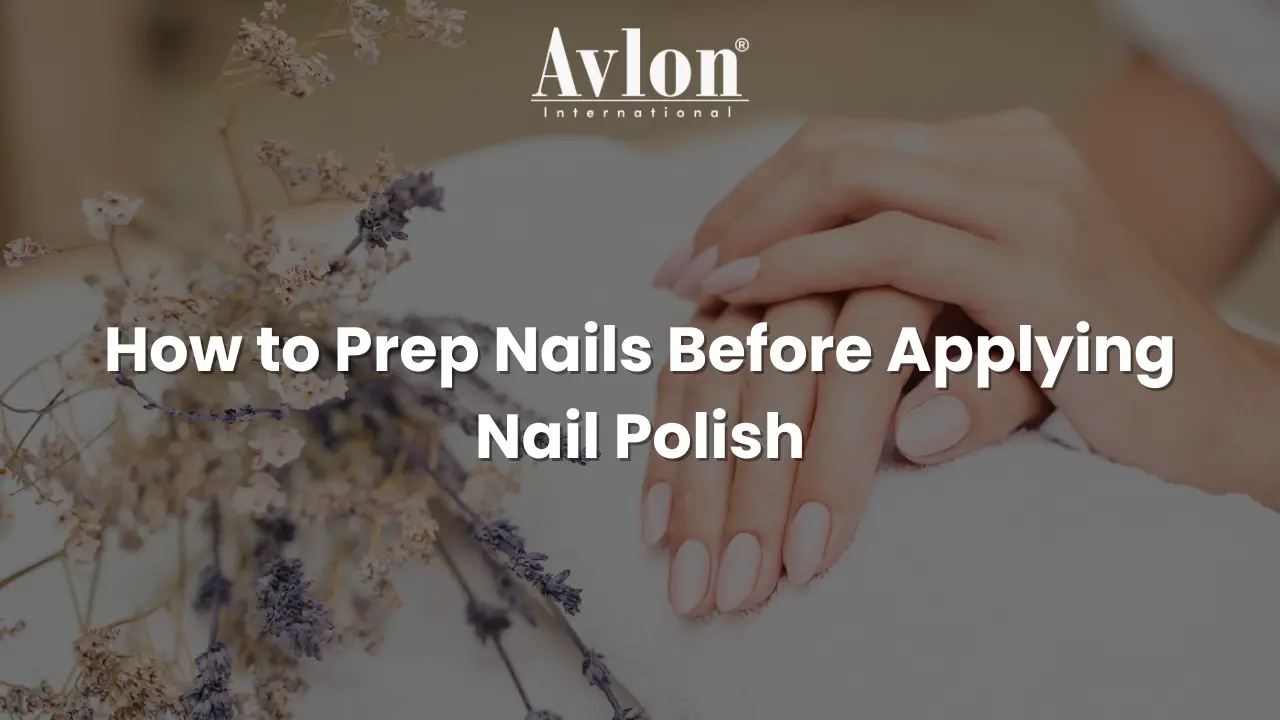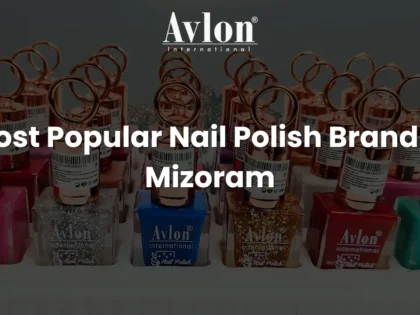How to Prep Nails Before Applying Nail Polish

For Distributors & Wholesalers
We welcome partnerships with distributors and wholesalers who wish to expand their business with a trusted and growing cosmetic brand.
Why Partner with Avlon International?
- Wide range of cosmetics: Nail polish, mascara, kajal, eyeliner, liquid lipstick, lipstick & more.
- Premium quality with competitive wholesale pricing.
- Attractive margins and fast-moving products.
- Assured support with marketing materials & promotional offers.
- PAN India shipping with secure packaging.
📦 Minimum Order Quantity (MOQ): 1 master carton (72 trays)
💰 Special Discounts: Available for bulk & long-term partners.
🚚 Dispatch & Delivery: PAN India in around 10-15 days.
📞 Contact Us:
Phone / WhatsApp: +91 88105 67775
Email: contactus@avloninternational.com
Website: www.avloninternational.com
Let’s be honest – we’ve all been there. You’re rushing to get ready for a big event, slap on some nail polish without any prep work, and by the next morning, your manicure looks like it went through a blender. Sound familiar? Well, buckle up, because we’re about to transform your nail game from tragic to magic with the ultimate guide on how to prep nails before applying nail polish.
Think of nail preparation as the foundation of a house. You wouldn’t build a mansion on quicksand, would you? Similarly, you can’t expect your nail polish to look salon-perfect and last for weeks without proper preparation. It’s like expecting to win a marathon without training – theoretically possible, but highly unlikely and probably painful.
Why Nail Preparation Matters More Than You Think
Before we dive into the nitty-gritty of nail prep, let’s talk about why this step is absolutely crucial. Proper nail preparation isn’t just some fancy beauty ritual invented to sell more products (though let’s be real, the beauty industry does love a good multi-step process). It’s actually the secret sauce that separates amateur nail art from professional-looking manicures.
When you prep your nails correctly, you’re essentially creating the perfect canvas for your polish. Imagine trying to paint a masterpiece on a dirty, uneven surface – the paint would chip, peel, and look generally awful. Your nails work the same way. Without proper preparation, even the most expensive polish will look cheap and won’t last longer than your morning coffee.
Professional nail technicians and beauty experts consistently emphasize that nail preparation accounts for about 80% of a manicure’s success. The remaining 20% is technique and product quality. This means that even if you’re using premium products from brands like Avlon International, skipping the prep work will sabotage your results faster than you can say “chip city.”
The Science Behind Nail Preparation
Your nails are basically keratin plates that are constantly exposed to water, soap, oils from your skin, and environmental pollutants. Over time, these elements create a barrier that prevents polish from adhering properly. When you prepare your nails correctly, you’re removing these barriers and creating optimal conditions for polish adhesion.
The natural oils from your cuticles and nail bed are particularly problematic for polish longevity. These oils act like tiny slip-and-slides for your polish, causing it to lift and peel prematurely. Additionally, dead skin cells and microscopic debris can create an uneven surface that makes your polish application look bumpy and unprofessional.
Essential Tools for Perfect Nail Preparation
Before we jump into the step-by-step process, let’s gather our weapons of mass beautification. Having the right tools makes the difference between a frustrating experience and a zen-like nail prep session that you actually enjoy.
You’ll need a good quality nail file – preferably glass or high-grade emery board. Cheap files are like using sandpaper on silk; they’ll do more harm than good. A cuticle pusher (metal or wooden orange stick) is essential for dealing with overgrown cuticles without causing damage. Sharp, clean cuticle nippers are crucial if you plan to trim any excess cuticle tissue.
Don’t forget a buffer block for smoothing ridges and creating an even surface. Cotton pads or lint-free wipes are necessary for cleaning, and you’ll need a good dehydrator or rubbing alcohol to remove oils and moisture. Quality products from reputable brands like Avlon International can make a significant difference in both the prep process and final results.
Step-by-Step Nail Preparation Process
Step 1: Remove Old Polish Completely
This might seem obvious, but you’d be surprised how many people do a half-hearted job removing old polish. Don’t just scrub until most of it comes off and call it good. Every trace of old polish needs to go, including those stubborn bits around the cuticles and under the nail tips.
Use a quality polish remover and be patient. Soak a cotton pad with remover, press it onto the nail for a few seconds to let it penetrate, then wipe away from the cuticle toward the tip. This prevents pushing polish residue into the cuticle area, which can cause staining and interfere with your new application.
Step 2: Shape Your Nails Like a Pro
Nail shaping is an art form that can make or break your entire look. The key is to file in one direction only – back and forth filing creates microscopic tears that weaken the nail and lead to breakage. Start with longer strokes from the outside edge toward the center, then refine the shape with shorter strokes.
Consider your lifestyle when choosing a shape. If you type all day or work with your hands, shorter, rounded shapes are more practical and less prone to breaking. If you want to make short fingers appear longer, go for an oval or almond shape. Square shapes work great for wider nail beds and give a classic, clean appearance.
Step 3: Cuticle Care – The Make-or-Break Step
Here’s where things get real. Your cuticles can either make your manicure look professionally done or like you did it in the dark while riding a roller coaster. Proper cuticle care involves softening, pushing back, and sometimes trimming excess tissue.
Start by soaking your hands in warm, soapy water for about five minutes. This softens the cuticles and makes them easier to work with. Gently push back the cuticles using your chosen tool, working in small circular motions. Be gentle – aggressive cuticle pushing can cause irritation and even infection.
If you have excess cuticle tissue (those little hangnails that catch on everything), carefully trim them with sharp cuticle nippers. Only remove dead tissue, and never cut living cuticle. When in doubt, leave it alone or consult a professional.
Step 4: Surface Preparation – Creating the Perfect Canvas
Now comes the technical part that separates amateur hour from professional results. Your nail surface needs to be completely clean, smooth, and slightly roughened for optimal polish adhesion. This is where many DIY manicures fail spectacularly.
Start by gently buffing the nail surface to remove ridges and create a smooth base. Don’t over-buff – you’re not trying to file your nails down to nothing. A few gentle passes with a fine-grit buffer should do the trick. Pay special attention to any ridges or imperfections that might show through your polish.
Next, clean the nail surface thoroughly. This is where products from brands like Avlon International really shine, as their dehydrators and cleansers are specifically formulated to remove oils and prep the nail surface. Apply the dehydrator to a lint-free pad and wipe each nail from cuticle to tip, making sure to get the entire surface.
Step 5: The Final Clean – Removing Every Trace of Oil and Debris
This step is absolutely critical and often overlooked. Even after buffing and dehydrating, there can still be microscopic particles and oils on your nails that will interfere with polish adhesion. Think of this as the final inspection before the main event.
Use a fresh cotton pad with rubbing alcohol or a professional nail dehydrator to give each nail a final wipe-down. Make sure to get under the nail tips and around the cuticle area. Let your nails air dry for a minute or two before applying any base coat or polish.
Common Nail Prep Mistakes That Ruin Your Manicure
Even with the best intentions, it’s easy to make mistakes during nail preparation that will come back to haunt you later. One of the biggest mistakes is rushing through the process. Nail prep isn’t something you can speed through while binge-watching your favorite show. It requires attention and patience.
Another common error is using dull or dirty tools. A dull file can cause nail splitting, while dirty tools can introduce bacteria and cause infections. Keep your tools clean and replace them regularly. Investing in quality tools from reputable brands like Avlon International might cost more upfront, but they’ll last longer and give better results.
Over-buffing is another manicure killer. Some people think that if a little buffing is good, more must be better. Wrong! Over-buffing thins the nail plate and can cause permanent damage. You want to smooth the surface, not sand it down to nothing.
Professional Tips for Different Nail Types
Not all nails are created equal, and different nail types require slightly different preparation approaches. If you have naturally oily nails (yes, that’s a thing), you’ll need to be extra thorough with the dehydrating step and might need to use a stronger dehydrator.
For dry, brittle nails, be gentler with the buffing and consider using a strengthening base coat after preparation. Thin nails require a delicate touch throughout the entire process, while thick nails might need more aggressive buffing to create a smooth surface.
Ridged nails need special attention during the buffing phase. Don’t try to buff out deep ridges completely in one session – this can thin the nail dangerously. Instead, use a ridge-filling base coat after gentle buffing to create a smooth surface for polish application.
The Role of Quality Products in Nail Preparation
While technique is crucial, the products you use can make a significant difference in your results. Professional-grade preparation products are formulated specifically for nail care and often contain ingredients that actually improve nail health while prepping for polish application.
Avlon International offers a range of professional nail care products that are designed to work together for optimal results. Their dehydrators and cleansers are formulated to remove oils and debris without over-drying the nail, while their buffers and files are designed to create the perfect surface texture for polish adhesion.
Cheap drugstore prep products might seem like a bargain, but they often contain harsh chemicals that can damage your nails over time. Investing in quality preparation products pays off in the long run with better-looking manicures that last longer and healthier nails overall.
Timing Your Nail Preparation
Proper nail preparation takes time – there’s no way around it. Plan for at least 30-45 minutes of prep time if you’re doing a thorough job on both hands. This isn’t including actual polish application time, just the preparation phase.
Many people try to rush through nail prep, but this almost always leads to subpar results. Think of nail preparation as meditation time – put on some relaxing music, light a candle, and make it an enjoyable self-care ritual rather than a chore to rush through.
If you’re short on time, it’s better to do a proper prep job and apply a simple polish than to rush through prep and attempt elaborate nail art. The prep work is what makes the difference between a manicure that looks professional and one that looks homemade.
Environmental Factors That Affect Nail Preparation
Believe it or not, environmental factors can significantly impact your nail preparation and the longevity of your manicure. Humidity is a major factor – high humidity can prevent proper dehydration of the nail surface, while very low humidity can make nails too dry and brittle.
Temperature also plays a role. Cold temperatures can make cuticles tougher and harder to push back, while very warm temperatures can cause your hands to sweat, adding oils back to the nail surface even after cleaning.
If you live in a particularly humid climate, you might need to use a fan or work in an air-conditioned room during nail prep. In dry climates, consider using a humidifier in your nail area to prevent over-drying of the cuticles and surrounding skin.
The Psychology of Perfect Nail Prep
Here’s something they don’t teach in beauty school – the mental aspect of nail preparation is just as important as the technical skills. When you take the time to properly prepare your nails, you’re not just creating a better surface for polish. You’re also setting yourself up for success mentally.
There’s something deeply satisfying about the methodical process of nail preparation. Each step builds on the previous one, creating a sense of accomplishment and attention to detail that carries over into the polish application. When you know your nails are properly prepped, you approach the actual manicure with confidence rather than anxiety.
This psychological aspect is why many people find nail care to be therapeutic. The repetitive motions, the attention to detail, and the visible improvement in your nails can be incredibly calming and satisfying.
Maintaining Your Prepped Nails
Once you’ve gone through the effort of properly preparing your nails, you want to maintain them between manicures. This doesn’t mean doing the full prep routine every few days, but there are simple maintenance steps that can extend the life of your manicure and keep your nails healthy.
Daily cuticle oil application keeps the cuticles soft and prevents hangnails. Wearing gloves when cleaning or doing dishes protects your manicure from harsh chemicals and excessive water exposure. Regular hand moisturizing keeps the surrounding skin healthy and makes your next nail prep session easier.
Quality maintenance products from brands like Avlon International are designed to work with their preparation products, creating a complete nail care system that keeps your nails healthy and beautiful between salon visits or at-home manicures.
Troubleshooting Common Prep Problems
Even with the best intentions and techniques, sometimes things go wrong during nail preparation. Maybe you accidentally nicked a cuticle, or you notice a crack in your nail after filing. Don’t panic – most prep problems have simple solutions.
For minor cuticle cuts, clean the area with rubbing alcohol and apply a small amount of antibiotic ointment. For small nail cracks, you can often repair them with a nail glue or silk wrap system before continuing with your prep.
If you discover a major nail problem during prep, like a significant crack or infection, it’s better to postpone your manicure and address the issue properly rather than trying to polish over the problem.
The Bottom Line on Nail Preparation
Perfect nail preparation isn’t just about following a checklist of steps – it’s about understanding why each step matters and adapting the process to your specific needs. When you take the time to properly prepare your nails, you’re not just ensuring a better-looking manicure. You’re also taking care of your nail health and setting yourself up for long-term success with your at-home nail care routine.
Remember, nail preparation is a skill that improves with practice. Don’t expect perfection on your first try, and don’t get discouraged if your early attempts don’t look salon-perfect. With time, patience, and quality products from trusted brands like Avlon International, you’ll develop the skills and confidence to create professional-looking manicures at home.
The investment in proper nail preparation techniques and quality products pays dividends in the form of longer-lasting manicures, healthier nails, and the satisfaction of knowing you can create beautiful nail looks whenever the mood strikes. So next time you’re tempted to skip the prep work and jump straight to the fun part, remember – great nails aren’t built in a day, but they’re definitely built on a foundation of proper preparation.
📌 Disclaimer
The information provided in this blog is for general informational purposes only. While Avlon International makes every effort to ensure the accuracy and reliability of the information shared, we make no representations or warranties of any kind, express or implied, about the completeness, accuracy, reliability, suitability, or availability with respect to the content.
Any reliance you place on such information is therefore strictly at your own risk. Avlon International shall not be held liable for any loss, damage, or inconvenience arising in connection with the use of this blog or its content.
For official details regarding our products, distributor policies, or business partnerships, please contact us directly at WhatsApp +91 88105 67775.




